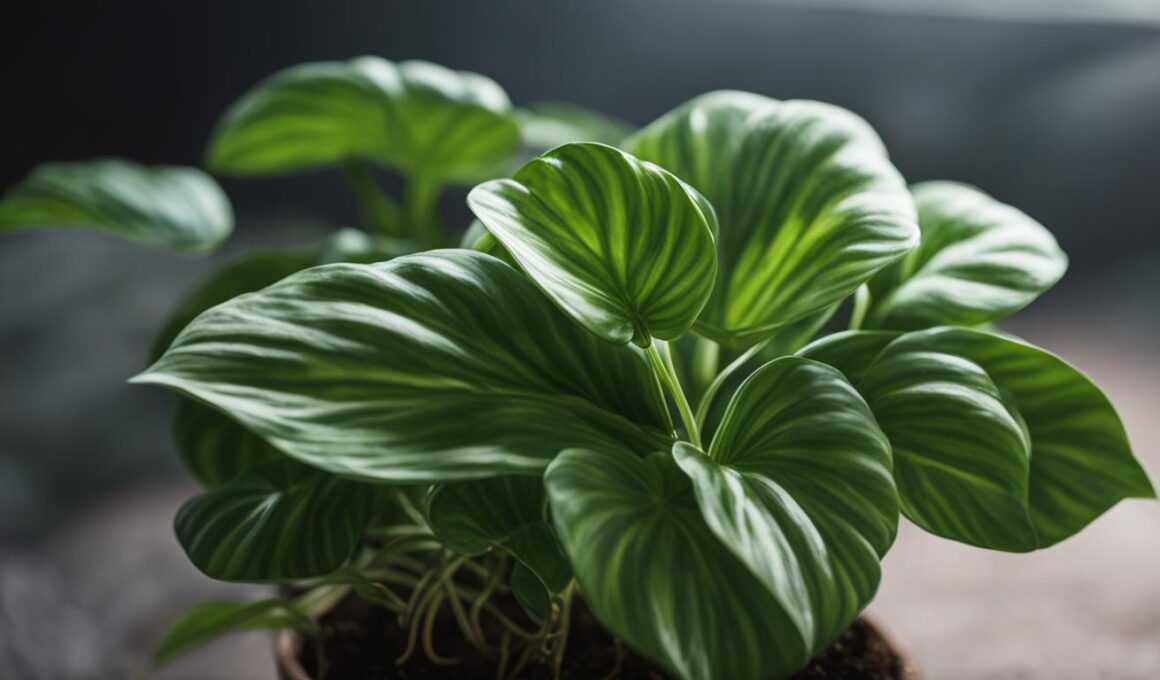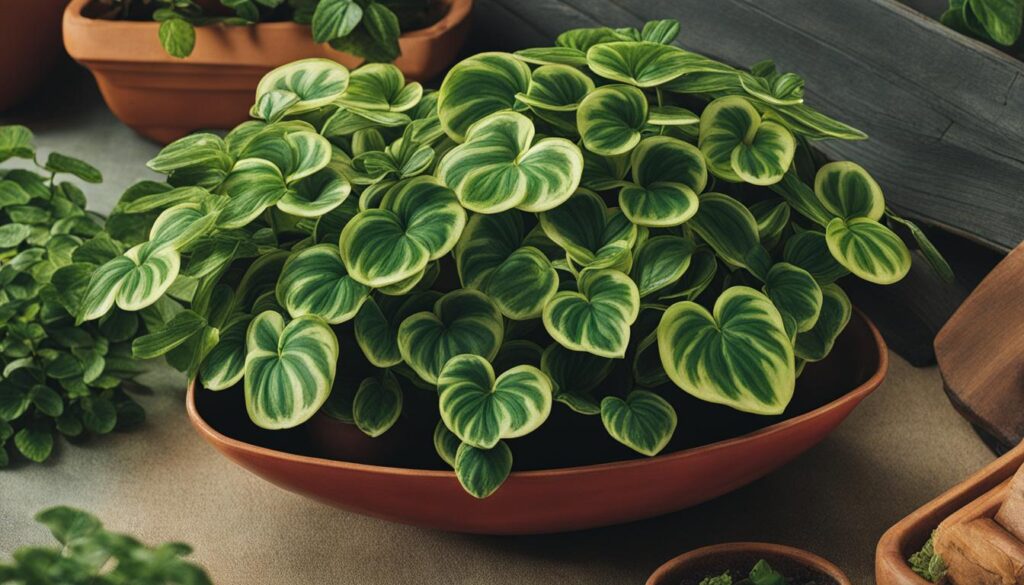Caring for your Watermelon Peperomia might seem straightforward, but various factors can lead to drooping leaves, affecting your plant’s overall health and appearance. Being aware of common issues and their signs is vital for reviving drooping Peperomia and ensuring a lush, vibrant, and healthy plant. In this article, we provide a comprehensive guide to help you address your Watermelon Peperomia care needs and troubleshoot any problems you may encounter.
Key Takeaways
- Underwatering, overwatering, and low humidity are frequent causes of drooping in Watermelon Peperomia plants.
- Environmental stressors like temperature fluctuations, overfertilization, and transplant shock can also lead to drooping leaves.
- Ensure adequate soil moisture levels with proper watering practices to avoid overwatering or underwatering your plant.
- Address humidity issues by maintaining a balanced level of at least 40% for optimal plant health.
- Monitor and treat any diseases or pest infestations immediately to prevent long-term damage to your Watermelon Peperomia.
Common Causes for Drooping in Watermelon Peperomia Plants
Drooping in Watermelon Peperomia can result from a variety of factors that adversely affect the plant’s overall health. Whether it’s due to inadequate watering practices, environmental stressors, or disease, understanding the causes is key to providing optimal care for this popular indoor plant.
The most common reasons for drooping in Watermelon Peperomia plants include:
- Inadequate watering
- Environmental factors
- Overfertilization
- Transplant shock
- Diseases and pests
Inadequate watering practices
, such as overwatering or underwatering, can compromise the structural integrity of the plant. It’s important to achieve a delicate balance between providing adequate moisture and avoiding waterlogged conditions to ensure your Peperomia stays healthy.
Environmental factors
, including low humidity, improper light levels, and extreme temperature fluctuations can significantly contribute to a sagging appearance in your Peperomia. Ensure that your plant receives sufficient light, is kept in a comfortable temperature range, and benefits from humidity levels suitable for its needs.
Overfertilization
can introduce excessive salts into the soil, causing damage to your plant. Stick to a regular fertilization schedule, using a suitable houseplant fertilizer, and be mindful not to overdo it.
Transplant shock
refers to the stress experienced by a plant during repotting or relocation. This can be minimized by carefully transplanting your Peperomia, being gentle with the roots and adjusting it to its new environment gradually.
Diseases and pests
are often the culprits behind drooping Peperomia plants. Look out for common disease conditions such as root rot, Rhizoctonia leaf spot, Phyllostica leaf spot, and Sclerotium stem rot, which can all contribute to a wilting appearance.
| Cause of Drooping | Indicators | Measures to Address Issue |
|---|---|---|
| Inadequate watering | Wilting, yellowing leaves, soft stems | Adjust your watering practices, monitor soil moisture |
| Environmental factors | Leggy growth, discolored leaves, general decline | Optimize light, temperature, and humidity levels |
| Overfertilization | Burned leaf tips, poor growth, excess salt buildup | Follow recommended fertilization guidelines |
| Transplant shock | Sudden decline in plant health after repotting | Take care when repotting, minimize disturbance to roots |
| Diseases and pests | Various symptoms, depending on the specific disease or pest | Diagnose and treat accordingly; monitor plant health |
In conclusion, identifying and addressing the underlying causes of Peperomia droop is vital to plant care and indoor gardening. By understanding these common Peperomia problems and monitoring your plant’s health, you’ll be better equipped to keep your Watermelon Peperomia looking its best and thriving in your home.
Addressing Underwatering: Tips to Hydrate Your Peperomia
When it comes to restoring the health of a dehydrated Watermelon Peperomia, it’s essential to recognize the underwatering symptoms early on and take corrective measures. Underwatering can manifest as leaf curling initially, but may progress to more pronounced drooping as the plant tries to conserve water.
Fortunately, addressing dehydration in your Watermelon Peperomia isn’t overly complex. The solution involves allowing the soil to dry several inches before watering and adjusting the watering schedule in response to seasonal temperature changes. You can rely on various tools and techniques to maintain a consistent and optimal watering routine. These may include:
- Performing fingertip tests to gauge soil moisture
- Using moisture meters to assess soil humidity accurately
- Incorporating self-watering pots to ensure adequate moisture
Be gentle when rehydrating a plant that has suffered from underwatering, as it’s vital to avoid overwhelming it. Adopt light and consistent watering practices to provide the necessary Peperomia hydration while promoting recovery.
Striking the right balance between keeping the soil moist but not waterlogged is key to the well-being of your Watermelon Peperomia. To achieve this, it’s helpful to understand the soil moisture requirements for your specific plant. The table below offers guidance on the optimal soil moisture conditions for various stages of Watermelon Peperomia growth:
| Growth Stage | Soil Moisture Level |
|---|---|
| Seedling | Slightly moist |
| Vegetative growth | Moist but well-drained |
| Flowering and fruiting | Evenly moist, avoiding excess water |
| Dormancy or rest period | Allow topsoil to dry between watering |
Adhering to these guidelines can help you provide the appropriate level of moisture to ensure the healthy and thriving Watermelon Peperomia you desire.
Combatting Overwatering and Root Rot in Watermelon Peperomia
Overwatering is a common cause of Watermelon Peperomia drooping, as it leads to waterlogged roots and root rot, compromising the plant’s health. In this section, we will discuss how to identify, rescue, and prevent overwatered Watermelon Peperomia plants.
Identifying Overwatered Plants
Overwatering signs in Watermelon Peperomia include mushy stems, wilted leaves, and a lack of structural firmness. The excess moisture impedes root function and may not become apparent until the external symptoms appear. To assess your plant’s health, keep an eye out for:
- Soggy soil
- A heavy pot
- Leaves that feel thinner than usual
Observing these indicators can help you intervene early and prevent further damage to your Watermelon Peperomia.
Steps to Rescue an Overwatered Watermelon Peperomia
To salvage an overwatered Watermelon Peperomia, follow these 5 steps:
- Remove the plant from its overly moist environment and examine the roots for signs of rot.
- Separate the plant from the soggy soil.
- Trim away any blackened or brown roots using disinfected shears.
- Repot the plant with fresh, dry potting mix.
- Maintain appropriate care, allowing the top inches of soil to dry before the next watering.
Monitor your plant’s response in the following days to assess recovery prospects. With proper care, your Watermelon Peperomia should bounce back.
Preventing Future Overwatering Issues
Implement these healthy watering practices to reduce the risk of overwatering your Watermelon Peperomia in the future:
| Method | Description |
|---|---|
| Responsive Watering Regimen | Establish a watering routine based on the plant’s needs in different seasons. |
| Moisture Meters | Use moisture meters to accurately assess soil humidity and determine when watering is necessary. |
| Top Few Inches Rule | Water the plant only when the top few inches of soil are dry—avoid sticking to a rigid schedule. |
By following these guidelines, you can support the well-being of your Watermelon Peperomia and ensure it remains lush and vibrant.
Optimizing Humidity Levels for Lush Watermelon Peperomia Foliage
Watermelon Peperomia requires a consistent humidity level of at least 40% to maintain its lush foliage and prevent leaf desiccation. Achieving optimal Humidity for Peperomia involves continuous monitoring of indoor conditions and taking appropriate measures to maintain the right level. In this section, we will outline various methods of increasing indoor humidity to cater to your Peperomia’s plant moisture needs.
Firstly, it is essential to monitor indoor humidity levels by using a hygrometer. This device allows you to keep track of humidity changes and make necessary adjustments. One way to maintain adequate humidity is by placing your plant in a naturally high-humidity area, such as a bathroom or indoor greenhouse.
There are also several other techniques to help you increase indoor humidity:
- Humidifiers: A cool-mist humidifier can significantly raise humidity levels in the room where the plant is placed.
- Misting: Gently mist your Watermelon Peperomia with water a few times a week to create a moisture-rich environment around the leaves.
- Pebble Trays: Fill a shallow tray with pebbles and water, then place the plant pot on the pebbles, ensuring the bottom of the pot does not come in contact with the water. As the water evaporates, it raises humidity around the plant.
While maintaining adequate humidity is essential for your Peperomia’s health, excessive moisture levels can lead to problems such as rot. Striking a balance is crucial; aim for moderate humidity levels to ensure the plant’s well-being. Regular monitoring and adjustments will help you maintain optimal conditions for your Watermelon Peperomia to thrive.
How Can I Revive a Drooping Peperomia Variety in My Indoor Garden?
To enhance your indoor garden with peperomia varieties, ensure your drooping plant gets adequate light, water, and a well-draining soil mix. Trim any yellow or wilted leaves, and consider repotting if the roots are crowded. Introduce a humidifier or pebble tray to increase moisture levels in the air.
Conclusion
Reviving a drooping Watermelon Peperomia requires a methodical approach to identify and address the root causes affecting your beloved plant’s health. Factors such as watering practices, humidity levels, fertilization, and environmental conditions can all contribute to the drooping appearance. By following this all-inclusive plant health guide and making necessary adjustments to your Peperomia care routine, you are well on your way to enjoying a thriving houseplant with vibrant foliage.
One of the key takeaways to remember is the importance of consistency in monitoring your plant’s progress and making appropriate changes as required. Investing time and effort in optimizing your Peperomia care practices ensures a happy, healthy living environment for your Watermelon Peperomia, ultimately leading to a visually appealing and lush indoor garden.
With patience, attention to detail, and the valuable Peperomia plant tips provided in this guide, you’ll soon be equipped with the necessary tools to bring your drooping Watermelon Peperomia back to life. Embrace the transformative power of informed plant caretaking and delight in the rejuvenation of your beloved houseplant.












